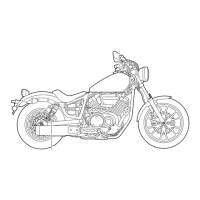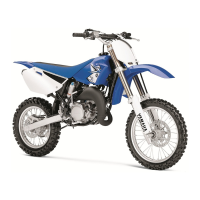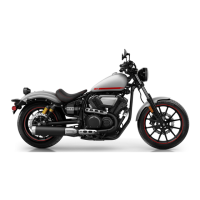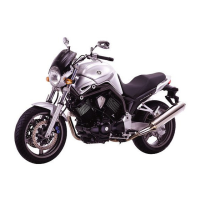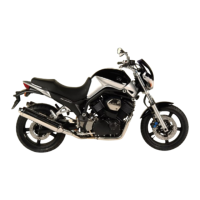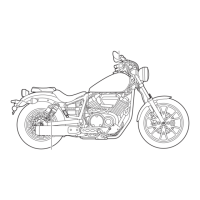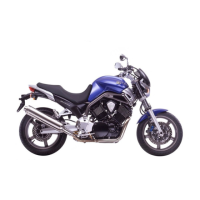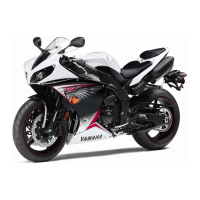Do you have a question about the Yamaha Bws YW125 and is the answer not in the manual?
Owner's responsibilities for safe operation, including training and following manual instructions.
Performing pre-operation checks, being visible, and knowing skills and limits.
Importance of helmets, face shields, jackets, trousers, and gloves for injury prevention.
Dangers of carbon monoxide from engine exhaust and necessary precautions.
Safe practices for adding cargo or accessories, weight distribution, and limits.
Risks of non-genuine parts and modifications affecting safety and performance.
Advice on signaling, braking on wet surfaces, cornering, and road hazards.
Identification of major components located on the left side of the scooter.
Identification of major components located on the right side of the scooter.
Location and basic function of all controls and instruments on the scooter.
Controls ignition, lighting, and steering lock functions.
Instructions on how to open and close the keyhole cover.
Explains the meaning and function of dashboard indicator lights.
Details the speedometer and odometer for tracking speed and distance.
Indicates the current fuel level in the tank.
Operation of switches for lights, signals, horn, engine stop, and start.
Location and operation of front and rear brake levers.
Procedure for opening and closing the fuel tank cap.
Safety guidelines for refueling, including fire hazards and fuel type.
Information on the catalytic converter and precautions for hot exhaust.
How to open and close the seat for access.
Location and use of the helmet holder under the seat.
Location and load limits for the under-seat storage.
Location and load limit for the luggage hook.
Operation of the sidestand and its relation to the ignition circuit cut-off system.
How the system prevents starting or stops the engine based on sidestand/brake status.
Step-by-step guide for starting the engine, including safety checks.
Procedure for moving the scooter from a standstill and beginning to ride.
How to control speed by operating the throttle grip.
Techniques for safe and effective braking, including warnings for wet conditions.
Advice to improve fuel efficiency based on riding style.
Recommended procedures for the initial 1000 km of operation for engine longevity.
Safe practices for stopping the engine and parking the scooter.
Location and contents of the tool kit for basic maintenance.
Instructions for accessing components by removing body panels.
How to check the spark plug for condition and adjust its gap.
Procedures for checking oil level and changing engine oil.
Procedures for checking and changing the final transmission oil.
How to inspect, clean, or replace air filter elements.
How to check and ensure correct engine idling speed.
Procedure for checking and adjusting throttle cable free play.
Importance of valve clearance and dealer adjustment intervals.
Checking tire condition, tread depth, and adjusting air pressure.
Precautions for checking cast wheels for damage and balancing.
Checking and adjusting free play for front and rear brake levers.
How to check front brake pads and rear brake shoes for wear.
Procedure for checking brake fluid level and refill precautions.
Inspecting and lubricating all control cables for smooth operation.
Lubricating the throttle grip and cable for optimal performance.
Lubricating the pivot points of the front and rear brake levers.
Checking and lubricating the centerstand and sidestand.
Checking the condition and smooth operation of the front fork.
Checking for play in the steering bearings.
Checking front and rear wheel bearings for play or smooth rotation.
Information on the VRLA battery, its charging, and maintenance.
Procedure for replacing blown fuses in the electrical system.
Guidance on replacing a burnt-out headlight bulb.
Procedure for replacing turn signal light bulbs.
General approach to diagnosing and resolving common scooter problems.
A diagnostic chart for fuel, compression, ignition, and battery issues.
Specific cleaning advice for matte finished parts to avoid damage.
Guidelines for cleaning, washing, and protecting the scooter from corrosion.
Procedures for short-term and long-term storage to maintain the scooter.
Key physical dimensions and weight of the scooter.
Details on engine type, displacement, oil, and fuel requirements.
Specifications for the chassis, tires, and wheels.
Information on the front/rear brakes, and suspension types.
Specifications for ignition, charging, and battery systems.
Wattage, voltage, and quantity for all lights.
Amperage ratings for various fuses in the scooter's electrical system.
Location for recording VIN and model label for parts ordering and registration.
Owner's responsibilities for safe operation, including training and following manual instructions.
Performing pre-operation checks, being visible, and knowing skills and limits.
Importance of helmets, face shields, jackets, trousers, and gloves for injury prevention.
Dangers of carbon monoxide from engine exhaust and necessary precautions.
Safe practices for adding cargo or accessories, weight distribution, and limits.
Risks of non-genuine parts and modifications affecting safety and performance.
Advice on signaling, braking on wet surfaces, cornering, and road hazards.
Identification of major components located on the left side of the scooter.
Identification of major components located on the right side of the scooter.
Location and basic function of all controls and instruments on the scooter.
Controls ignition, lighting, and steering lock functions.
Instructions on how to open and close the keyhole cover.
Explains the meaning and function of dashboard indicator lights.
Details the speedometer and odometer for tracking speed and distance.
Indicates the current fuel level in the tank.
Operation of switches for lights, signals, horn, engine stop, and start.
Location and operation of front and rear brake levers.
Procedure for opening and closing the fuel tank cap.
Safety guidelines for refueling, including fire hazards and fuel type.
Information on the catalytic converter and precautions for hot exhaust.
How to open and close the seat for access.
Location and use of the helmet holder under the seat.
Location and load limits for the under-seat storage.
Location and load limit for the luggage hook.
Operation of the sidestand and its relation to the ignition circuit cut-off system.
How the system prevents starting or stops the engine based on sidestand/brake status.
Step-by-step guide for starting the engine, including safety checks.
Procedure for moving the scooter from a standstill and beginning to ride.
How to control speed by operating the throttle grip.
Techniques for safe and effective braking, including warnings for wet conditions.
Advice to improve fuel efficiency based on riding style.
Recommended procedures for the initial 1000 km of operation for engine longevity.
Safe practices for stopping the engine and parking the scooter.
Location and contents of the tool kit for basic maintenance.
Instructions for accessing components by removing body panels.
How to check the spark plug for condition and adjust its gap.
Procedures for checking oil level and changing engine oil.
Procedures for checking and changing the final transmission oil.
How to inspect, clean, or replace air filter elements.
How to check and ensure correct engine idling speed.
Procedure for checking and adjusting throttle cable free play.
Importance of valve clearance and dealer adjustment intervals.
Checking tire condition, tread depth, and adjusting air pressure.
Precautions for checking cast wheels for damage and balancing.
Checking and adjusting free play for front and rear brake levers.
How to check front brake pads and rear brake shoes for wear.
Procedure for checking brake fluid level and refill precautions.
Inspecting and lubricating all control cables for smooth operation.
Lubricating the throttle grip and cable for optimal performance.
Lubricating the pivot points of the front and rear brake levers.
Checking and lubricating the centerstand and sidestand.
Checking the condition and smooth operation of the front fork.
Checking for play in the steering bearings.
Checking front and rear wheel bearings for play or smooth rotation.
Information on the VRLA battery, its charging, and maintenance.
Procedure for replacing blown fuses in the electrical system.
Guidance on replacing a burnt-out headlight bulb.
Procedure for replacing turn signal light bulbs.
General approach to diagnosing and resolving common scooter problems.
A diagnostic chart for fuel, compression, ignition, and battery issues.
Specific cleaning advice for matte finished parts to avoid damage.
Guidelines for cleaning, washing, and protecting the scooter from corrosion.
Procedures for short-term and long-term storage to maintain the scooter.
Key physical dimensions and weight of the scooter.
Details on engine type, displacement, oil, and fuel requirements.
Specifications for the chassis, tires, and wheels.
Information on the front/rear brakes, and suspension types.
Specifications for ignition, charging, and battery systems.
Wattage, voltage, and quantity for all lights.
Amperage ratings for various fuses in the scooter's electrical system.
Location for recording VIN and model label for parts ordering and registration.
| Displacement | 125cc |
|---|---|
| Fuel System | Fuel Injection |
| Front Suspension | Telescopic fork |
| Rear Suspension | Unit Swing |
| Rear Brake | Drum |
| Front Tire | 120/70-12 |
| Rear Tire | 130/70-12 |
| Bore x Stroke | 52.4 mm x 57.9 mm |
| Starting System | Electric |
| Front Brake | Single disc |
